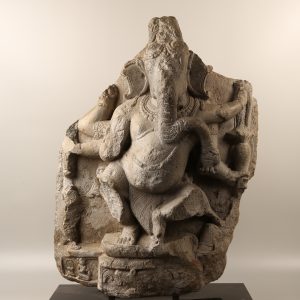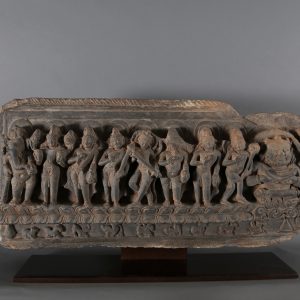Sūrya Head
12 000,00€
Sūrya Head (P687)
Terracotta
Bangladesh
4th-6th century, Gupta period
H. 21 cm
360° View
Description
The majesty of Sūrya
The god Sūrya, god of the Sun, is probably represented here. He wears a serene, subtle indolent expression, while his full lips seem to be smiling in a knowing way. Heavy eyelids fall over his almond-shaped eyes, surmounting a straight, thin nose. Despite the absence of some of its attributes, these features are characteristic of the representation of Sūrya during the Gupta period, as are the well-drawn curls that frame his round face. A richly ornamented diadem surmounts the god’s head, giving him a majestic aura that was once underlined by a nimbus, which only a part has been preserved from the ravages of time. The left earring is also preserved, a testimony to the care given to ornamentation in the Gupta period.
The Golden Age of Indian Art
The Gupta period is often referred to as the golden age of Indian art. The important development of art and literature, as well as the emergence of numerous regional workshops, gave rise to a taste for ornamentation, as well as for the refined character of representations. Terracotta became a material of choice for artists, as this head of Sūrya shows. Terracotta was given a major decorative role, particularly in the ornamentation of temples and stupas, which were entirely covered with sculptures, pillars and lintels. Terracotta is used for both secular and mythological representations, and this work belongs to the second category, bearing witness to the know-how of Bangladeshi artists.
A witness to Gupta art
In fact, Gupta art has often come down to us in religious form; this is probably due to the quality of execution and the particular care given to this type of work. This representation of the Sun God is a virtuoso demonstration of Gupta art and its codes of beauty. The softness of the features and their atypical elegance is characteristic of this period, as is the richness of the ornamentation and jewellery. The use of terracotta, which gradually declined thereafter (with the exception of the Bengal region), is also very characteristic of this period. The degree of preservation of this work should also be emphasised, despite the apparent fragility of the terracotta.
Provenance : French private collection.





